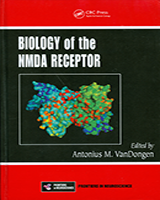From: Chapter 13, Activation Mechanisms of the NMDA Receptor

NCBI Bookshelf. A service of the National Library of Medicine, National Institutes of Health.
Subunit-subconductance model for NMDAR gating. The permeation pathway of the NMDAR is formed by two NR1 and two NR2 subunits (A). The conformation of each subunit alters between a “closed” conformation that does not support permeation (filled symbols) and an “open” conformation that does (open symbols). When the channel moves from the closed to the open state, each subunit must undergo a conformational change from closed to open. Unless the movements in the four subunits are strictly synchronized (due to an extreme form of positive cooperativity), heteromeric pore conformations (H1 through H3) will be visited in which one, two, or three subunits are in the open state. It was proposed that these heteromeric pore conformations can give rise to subconductance levels [95–97], predicting a complex structure for all open, close transitions (B). Because the heteromeric pore conformations are transition states expected to be short-lived, most of them may go undetected in single channel recordings because of the limited bandwidth of the measurements (C, D). NMDARs containing NR2A or NR2B subunits display an 80% subconductance level visited during transitions between the closed and fully open state. The subunit–subconductance model would explain this by assuming that one of the heteromeric pore conformations is relatively stable. Based on the relatively large size of the subconductance level, the relatively stable state would likely be H3.
From: Chapter 13, Activation Mechanisms of the NMDA Receptor

NCBI Bookshelf. A service of the National Library of Medicine, National Institutes of Health.